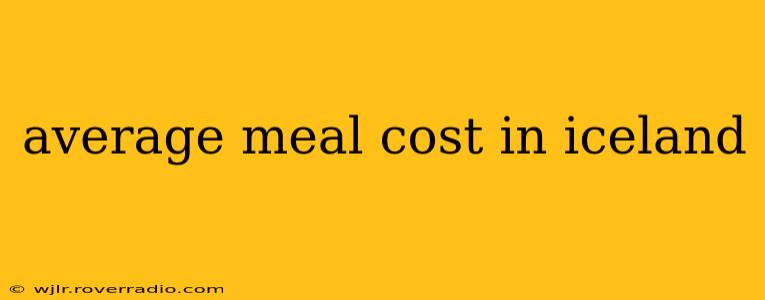Iceland, a land of fire and ice, offers breathtaking landscapes and a unique cultural experience. However, one aspect that often surprises visitors is the cost of living, particularly when it comes to food. This guide will delve into the average meal costs in Iceland, helping you budget effectively for your trip and avoid any unpleasant surprises.
What is the average cost of a meal in Iceland?
The average cost of a meal in Iceland varies significantly depending on several factors: the type of establishment, the location (Reykjavik is generally more expensive than smaller towns), and the type of food. A quick, inexpensive lunch might cost you around 2,500 ISK (approximately $20 USD), while a sit-down dinner at a mid-range restaurant could easily reach 6,000-8,000 ISK ($50-$65 USD) per person. Fine dining experiences will naturally be considerably more expensive.
How much should I budget for food in Iceland per day?
A realistic daily food budget in Iceland depends on your eating habits and preferences. For budget travelers utilizing grocery stores and preparing some meals themselves, a daily budget of 4,000-6,000 ISK ($30-$50 USD) per person might suffice. However, if you plan on eating out for most meals, you should expect to spend closer to 8,000-12,000 ISK ($65-$100 USD) per day, or even more depending on your choices.
What are the cheapest places to eat in Iceland?
For budget-conscious travelers, there are several options to keep food costs down:
- Grocery Stores: Shopping at stores like Bonus, Krónan, or Netto is significantly cheaper than eating out. You can purchase groceries for breakfast, lunch, and even simple dinners.
- Street Food: Look for hot dog stands and food trucks offering affordable and tasty options.
- Soup Restaurants: Many restaurants offer affordable and hearty soup options, perfect for a quick and filling meal.
- Cafés: While not always the cheapest option, cafes often offer lunch specials or affordable sandwiches and salads.
What is the average cost of groceries in Iceland?
Grocery costs in Iceland are generally higher than in many other countries. Expect to pay more for produce, dairy, and meat. However, staples like bread, pasta, and rice are often relatively affordable. It's wise to plan your grocery shopping in advance to minimize costs.
Is it expensive to eat out in Iceland?
Yes, eating out in Iceland can be expensive, especially in Reykjavik. Prices often reflect the high cost of importing food and the overall high cost of living. However, there are various options available to suit different budgets, from casual eateries to fine-dining establishments.
What are some tips for saving money on food in Iceland?
- Pack snacks: Bringing some snacks from home can help you avoid impulse purchases and save money on small meals.
- Take advantage of happy hour deals: Some restaurants offer discounts on drinks and food during happy hour.
- Look for lunch specials: Many restaurants offer cheaper lunch menus compared to their dinner menus.
- Self-catering: Preparing some of your meals in your accommodation is a cost-effective way to manage your food budget.
- Explore local markets: Look for farmers' markets or smaller shops that may offer more competitive pricing.
What's the average price of a beer or alcoholic drink in Iceland?
Alcohol in Iceland is generally more expensive than in many other European countries due to high taxes and strict regulations. Expect to pay significantly more for beer, wine, and spirits in bars and restaurants than you would in many other locations.
This guide provides a general overview of meal costs in Iceland. Your actual expenses will depend on your individual preferences and travel style. By planning ahead and utilizing some of the tips mentioned, you can manage your food budget effectively and enjoy your Icelandic adventure without breaking the bank.
